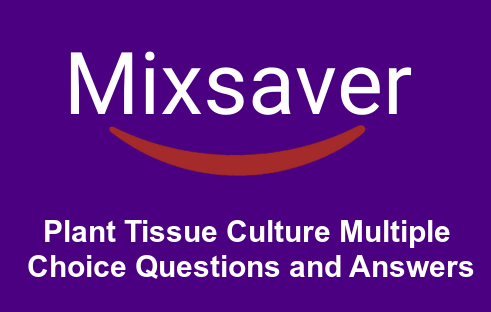Plant Tissue Culture mcq | Anatomy of Flowering Plants NEET Questions
1. According to which theory, the root and shoot apices are composed of three histogen layers namely a central plerome, outer dermatogen and underlying periblem?
(a) Hanstein theory
(b) Histogen theory
(c) Apical cell theory
(d) Tunica corpus theory
Ans. b
2. The cells of tunica undergo anticlinal divisions and give rise to
(a) epidermis
(b) cortex
(c) endodermis
(d) pericycle
Ans. a
3. The cells of corpus undergo divisions in various plants resulting in the formation of
(a) ground meristem
(b) procambium
(c) Both (a) and (b)
(d) only cortex
Ans. c
4. Root apical meristem (root apex) appears cup-shaped (roughly hemispherical) due to the presence of
(a) root cap
(b) root hairs
(c) quiescent centre
(d) None of these
Ans. c
5. Nageli (1858) has given which of the following theory of root apex organisation?
(a) Korper-Kappe theory
(b) Quiescent centre concept
(c) Apical cell theory
(d) None of these
Ans. c
6. Korper-Kappe theory was given by
(a) Nageli
(b) Schuepp
(c) Clowes
(d) All of these
Ans. b
Multiple Choice Questions on Plant Tissues | MCQ on Plant Tissue Culture
7. Which of the following theories was given by Hansteina
(a) Quiescent centre concept
(b) Apical cell theory
(c) Histogen concept
(d) None of the above
Ans. c
8. Quiescent centre concept theory was given by
(a) Nageli
(b) Schuepp
(c) Clowes
(d) All of these
Ans. c
Histological Organisation of Root & Shoot Apex
9. Apical cell theory of shoot apex is given by Hofmeister and supported by
(a) Clowes
(b) Nageli
(c) Both (a) and (b)
(d) None of these
Ans. b
10. Histogen theory of shoot apex organisation was given by Hanstein in which of the following year?
(a) 1856
(b) 1870
(c) 1921
(d) None of these
Ans. b
11. Tunica corpus theory of shoot apex organisation was given by
(a) Clowes
(b) Schmidt
(c) Nageli
(d) Both (a) and (b)
Ans. b
Anatomy of flowering plants neet mcq
12. Korper-Kappe theory of root apex organisation was given by Schuepp in which of the following year?
(a) 1905
(b) 1917
(c) 1921
(d) 1936
Ans. b
13. Root apex has three group of initials, i.e. dermatogen, periblem and plerome by which of the following theory?
(a) Korper-Kappe theory
(b) Quiescent centre concept
(c) Histogen theory
(d) None of the above
Ans. c
14. According to apical cell theory, gymnosperms have two groups of initials. In angiosperms, the number of initials are
(a) 2
(b) 1
(c) 3
(d) 4
Ans. c
15. Quiescent centre concept of root apex organisation was given by Clowes in which of the following year?
(a) 1858
(b) 1956
(c) 1917
(d) 1870
Ans. b
16. Schmidt gave tunica corpus theory in which year?
(a) 1924
(b) 1985
(c) 1958
(d) 1870
Ans. a
17. Tunica corpus theory of apex organisation is related to
(a) root apex
(b) shoot apex
(c) Both (a) and (b)
(d) None of these
Ans. b
18. In Korper-Kappe theory, a cell first divides transversely and thereafter one of its daughter cell divides longitudinally. This is known as
(a) B-division
(b) C-division
(c) Y-division
(d) T-division
Ans. d
Anatomy of flowering plants mcq for neet pdf
19. According to histogen theory of root apex, periblem gives rise to
(a) cortex
(b) endodermis
(c) Both (a) and (b)
(d) None of these
Ans. c
20. Which of the following layers gives rise to vascular tissue in root apex according to histogen theory?
(a) Dermatogen
(b) Periblem
(c) Plerome
(d) All of these
Ans. c
21. The apical meristem of the root is present
(a) only in radicals
(b) only in tap roots
(c) only in adventitious root
(d) in all roots
Ans. d
22. In a longitudinal section of a root, starting from the tip upward, the four zones occur in the following order
(a) root cap, cell division, cell enlargement, cell maturation
(b) root cap, cell division, cell maturation, cell enlargement
(c) cell division, root cap, cell enlargement, cell maturation
(d) cell division, cell enlargement, cell maturation, root cap
Ans. a
23. Root cap is formed by
(a) dermatogen
(b) calyptrogen
(c) vascular cambium
(d) periblem
Ans. b
MCQ on Anatomy of flowering plants
24. In a dicotyledonous stem, the sequence of tissues from the outside to the inside is
(a) phellem -pericycle-endodermis-phloem
(b) phellem-phloem- endodermis- pericycle
(c) phellem-endodermis- pericycle- phloem
(d) pericycle-endodermis-phellem-phloem
Ans. c
25. The quiescent centre in root meristem serves as a
(a) site for storage of food which is utilized during maturation
(b) reservoir of growth hormones
(c) reserve for replenishment of damaged cells of the meristem
(d) region for absorption of water
Ans. c
26. Phellogen is known as
(a) periderm
(b) cork cambium
(c) vascular cambium
(d) None of these
Ans. b
27. Which of the following is not associated with Histogen theory?
(a) Plerome
(b) Phelloderm
(c) Periblem
(d) dermatogen
Ans. b
MCQs on Plant Tissues
28. The root epidermis formed from
(a) plerome
(b) dermatogen
(c) periblem
(d) None of these
Ans. b
29. The histogen layer present at the apex of the root tip is called
(a) procambium
(b) calyptrogen
(c) dermatogen
(d) plerome
Ans. b
30. In a woody dicotyledonous tree, which of the following parts will mainly consists of primary tissues
(a) all parts
(b) stem and root
(c) flower, fruit and leaves
(d) shoot tips and root tips
Ans. c





